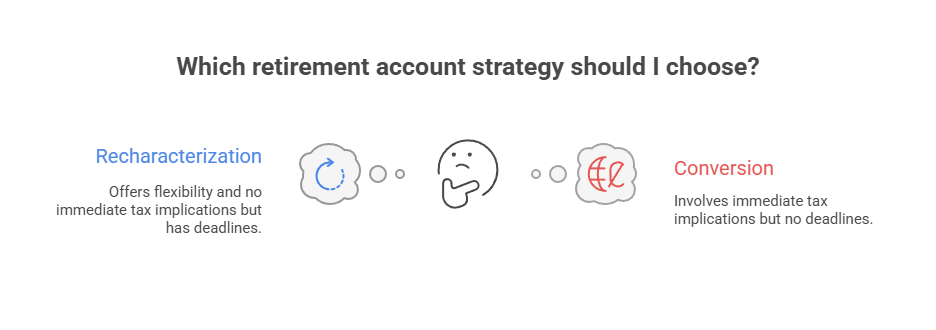Contributed by: AndyS, FreeTaxUSA Agent, Tax Pro

Understanding the difference between an IRA recharacterization and an IRA conversion can be a bit tricky. While they might seem similar, it's important to know how they differ. The way these transactions are reported on your tax return can vary significantly and might impact what you owe in income tax.
What is an IRA recharacterization?
Simply put, an IRA recharacterization allows you to ‘rewind time’ for your IRA contributions. For example, if you contribute to a Roth IRA and realize you didn’t really want to do that, you can recharacterize the entire contribution, plus earnings, to act as if you contributed to a traditional IRA in the first place.
You can recharacterize in either direction with Roth to traditional or vice versa. As long as the recharacterization is done by the tax filing deadline – or extension deadline if you filed an extension - for the same year as the contribution, you’ll be able to correct the contribution made to the wrong type of IRA.
How it Works
- Identify the contribution to recharacterize: This applies only to your annual, regular IRA contributions, not to any conversions or rollovers from other retirement plans.
- Transfer the funds: You must transfer the entire amount of the contribution, plus any earnings it has generated, or minus any losses, to the other type of IRA.
- Perform a trustee-to-trustee transfer: The recharacterization must be done through a transfer between financial institutions or within the same institution. You can’t be issued a check and then re-contribute the funds.
- Meet the deadline: You must complete the recharacterization by the tax filing deadline for the year the original contribution was made, including extensions.
- Report it: You need to report the recharacterization on your tax return using the information on your Form 1099-R.
Why would you need to recharacterize?
- You made a mistake: You initially contributed to a traditional IRA but later discovered your income was too high to qualify for an IRA deduction, or you would have preferred the deferred tax benefits of a Roth IRA. Or maybe you initially contributed to a Roth IRA but later discovered your income was too high to be eligible to contribute.
- Change in income: Your income changed after you contributed, making a different IRA type more advantageous for you.
What is an IRA conversion?
While an IRA conversion may seem like a recharacterization, there are some key differences that determine what type of transaction you may need to make if you need to change your IRA contributions.
A conversion takes a pre-tax account such as a traditional IRA and converts the account to a Roth IRA, a post-tax account. You can’t convert the account the other way (Roth to traditional). You don’t need to convert the full contribution made, it can be a partial amount, and there isn’t a time restriction on a conversion like there is for a recharacterization. A conversion can happen at any time during the year, with the goal to be before the end of the year, but can be done after year’s end if needed.
How it works
- Choose your method: You have a little more flexibility with a conversion. You can have a "trustee-to-trustee" transfer, or you can do a 60-day rollover. The rollover does carry more risk, as you receive a check and must deposit the funds within 60 days to avoid taxes and penalties.
- Pay the taxes: The amount you convert is added to your taxable income for that year since it was originally from pre-tax funds. You can pay taxes with an estimated tax payment, with your tax return when you file, or directly from the conversion amount, although this means less money will be invested in the Roth account.
- Report it: You need to report the conversion on your tax return when entering your Form 1099-R.
- Five-Year Rule: You must hold the converted funds in your Roth IRA for at least five years to avoid a 10% penalty on early withdrawals.
Why would you want to do a conversion?
- Lower-income years: You may be in a lower tax bracket during periods of unemployment or a job change, making the conversion less expensive with the increased tax liability. This gives you the benefit of a Roth during your retirement years.
- To bypass Roth IRA income limits: If your income is too high to contribute directly to a Roth IRA, you can use the "backdoor Roth" strategy by converting funds from a traditional IRA.
- You aren’t ready to withdraw retirement income: When you reach the IRS’ designated retirement age, you’re required to take a Required Minimum Distribution (RMD) from your traditional IRA accounts. If you have income from other sources and are not yet ready to start taking distributions from your IRA, you may choose to convert your traditional IRA to a Roth. Since Roth IRAs don’t have RMDs, you'll no longer be required to take annual withdrawals after the year of conversion.

Conclusion
While you may start the year with specific income expectations and plans, sometimes life events can change things. To avoid certain tax situations or to receive the tax benefit of an IRA deduction, it may be necessary to adjust your original retirement contribution plans. You may want to consult with a licensed tax professional or financial advisor to ensure making an IRA conversion or recharacterization is in your best financial interest.